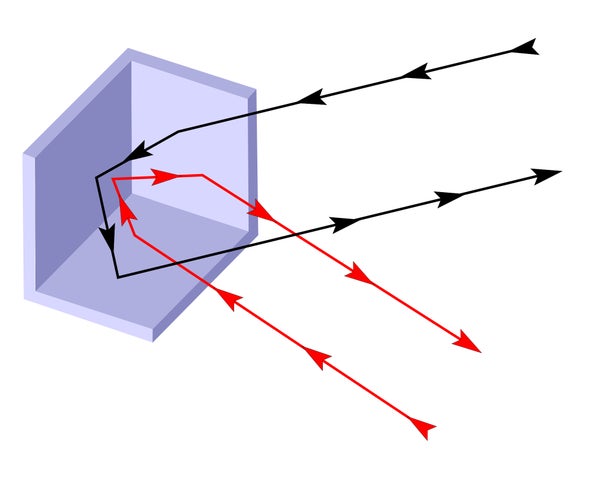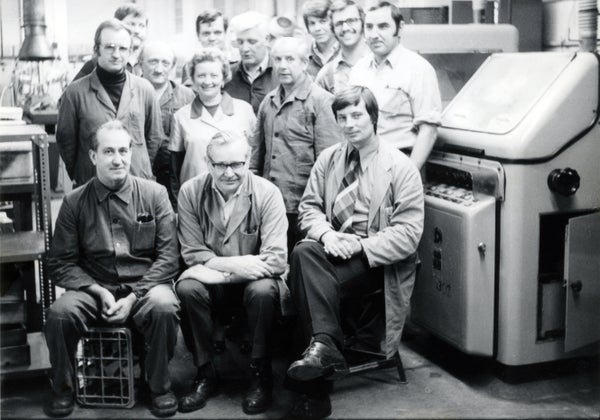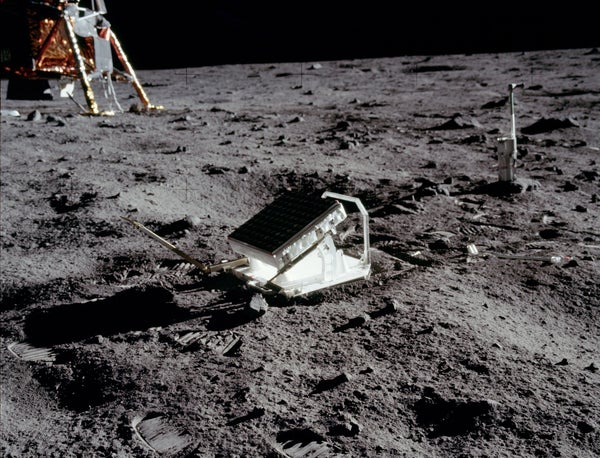This article was published in Scientific American’s former blog network and reflects the views of the author, not necessarily those of Scientific American
When Neil Armstrong took one small step onto the surface of the moon 50 years ago, the achievement was a triumph for American technology, giving the U.S. bragging rights over the rival Soviet Union in the bitterly contested Cold War. But the space race also created an internal science race to determine what experiments would be on board the first mission to land humans on another world.
One of the winners was a device that allowed scientists to measure the distance between our planet and its satellite with unprecedented precision—an experiment that was not only crucial in testing general relativity and understanding the moon’s subtle wobbles as it spins on its own axis, but was also astonishingly simple compared with the immense complexity of the overall mission.
In 1963, James Faller joined the Joint Institute for Laboratory Astrophysics (JILA) of the National Bureau of Standards and University of Colorado, Boulder. As a graduate student at Princeton University in the late 1950s, he had written a paper titled “A Proposed Lunar Package: A Corner Reflector on the Moon,” envisioning a durable, lightweight reflector weighing only two to three pounds that would be deployed on the moon. A light beam from Earth would be targeted at the reflector; the instrument would detect the laser and reflect the light back to Earth. The time it took for the light to make the round trip from the Earth to the Moon and back would, he wrote, “permit a precise earth-moon distance measurement to be made.”
On supporting science journalism
If you're enjoying this article, consider supporting our award-winning journalism by subscribing. By purchasing a subscription you are helping to ensure the future of impactful stories about the discoveries and ideas shaping our world today.
He gave his research paper to his professor, Robert Henry Dicke, a physicist who had made important contributions to the fields of astrophysics, atomic physics and gravity. When he turned in his paper, Faller handwrote at the very top: “Professor Dicke, would you see if this makes any sense?”
Less than a decade later, the world would know how insightful Faller’s proposal had been. Along with JILA colleagues Jan Hall and Peter Bender, he established a lunar ranging team to explore the feasibility of putting a retroreflector on the Moon. There was no guarantee that the experiment would actually fly: other groups were developing competing proposals in the hope of being selected for Apollo’s historic voyage.
But luck—along with NASA’s strict requirements for size, weight, speed and simplicity—gave the reflector an edge. NASA officials believed Apollo 11 had a high risk for an abort after the landing, so any experiment had to be set up and deployed within 10 minutes. Faller recalled, “The astronauts had limited time to spend on the lunar surface to position the array aiming back towards the Earth. In other words, we were saved by the clock.”
A corner cube retroreflector—or rather, an array of them—offered an ideal design. An ordinary, single mirror would have worked in theory, but it would always need to be aimed precisely at the point where the incoming light had originated, so the light beam would be reflected directly back to the source in order to be timed. However, due to the rotation of the moon on its own axis and its rotation around the Earth, this perfect alignment would occur only on rare occasions—and even then, a tiny error in pointing would result in the light returning to a different spot. But these reflectors would be made of three mirrors, set precisely at right angles to each other, like the inside corner of a cardboard box. This design forces the incoming light to bounce off three surfaces, and the laws of optics guarantee that it will always bounce directly back to the source.

No matter what angle a light beam comes from, a three-corner reflector bounces it back at that same angle. Credit: Chetvorno Wikimedia.
As Faller’s experiment was getting the “go” from NASA, there was one more crucial step: finding someone to provide the array of specialized reflector mirrors to make the ranging possible. One advantage for our company, Heraeus, was that the fused quartz we manufactured was known to have the highest purity, making it resistant to any radiation ionization that would make normal glass darken while aging in outer space. High purity would also minimize absorption as well as the bubbles and inclusions that create little lenses or microreflectors that could cause the light to be improperly reflected.
The reflector had to meet NASA’s strict quality standards. It had to perform flawlessly. And the company had to commit in writing that it would last a minimum of 10 years while subjected to the harsh environment of space.
One final question remained: this was the 1960s, and Heraeus was a German company. World War II had ended just two decades earlier. Would this affect the selection process? Faller personally visited the Heraeus facility in Hanau, Germany, in 1968. Company executives learned that the fused silica arrays were down to two companies: Heraeus and General Electric.

The Heraus team that created the triple-prism reflector that flew on Apollo 11. Credit: Heraus
Today, Faller admits that he never went to GE. We at Heraus were fortunate that the message he got from NASA was clear: the paramount consideration had to be quality, to ensure experimental success.
And in the end, the experiment was wildly successful.
Luck, or the lack of it, was a factor in the days after the landing. At the University of California’s Lick Observatory, Faller and his team of scientists and students initially encountered difficulties because Apollo 11 landed miles off-course from its expected landing site. The moon was also too low in the sky to allow ranging without going through a fair amount of the Earth’s atmosphere.
Ranging resumed on August 1 when the moon was positioned more favorably in the sky. Under these conditions, the laser was fired 162 times before any returns from the lunar array were recognized. The final series of 120 laser beam shots, after some adjustments, yielded 80 detected returns.
Unlike Neil Armstrong’s “giant leap,” the ranging team’s progress was measured in smaller, more modest leaps. On August 1, Faller and the ranging team, with a timing precision of 0.1 microseconds, had established the distance to the moon with a single shot accuracy of eight meters, compared with an accuracy of about 1,200 meters measured with radar in the late 1950s.
Two days later, they improved that to six meters. Eventually the accuracy was brought down to a single millimeter.
The Lunar Laser Retroreflector experiments (they were also set up by the Apollo 14 and 15 astronauts) remain some of the most important scientific achievements of the Apollo missions), adding to our understanding of everything from general relativity to the internal structure of the moon. The first reflector remains the only piece of equipment still operating at the Apollo 11 landing site.
But as Jim Faller recently recalled, the events of the first lunar landing were not just the result of impressive technology and science, but of a few moments of good fortune as well. He said, “Science also contains the need for luck. And the Apollo program at that time needed some luck. Both our work and the Apollo program were lucky.”
